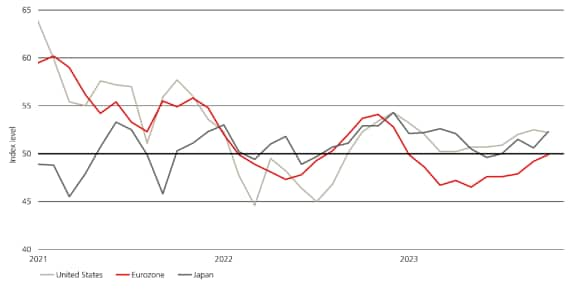
Highlights
Highlights
- Economic conditions are solid, and yet global central banks are still embarking on a synchronized easing cycle. This remains a uniquely positive backdrop for risk assets, in our view.
- Global growth is broadening out across regions and profits are holding up much better than expected.
- We believe falling bond volatility adds another bullish catalyst for risk assets.
- Of course, valuations for risk assets are elevated and increasingly reflect this risk backdrop. This implies slower, but still positive forward looking returns as long as the economy holds up.
- We favor comparatively cheap cyclical regions like Europe and Japan and are underweight more defensive markets like Switzerland and the UK.
We believe the rationale for risk-on, procyclical positioning can be distilled simply: Economic conditions are solid, and yet global central banks are still embarking on a synchronized easing cycle. This is a uniquely positive backdrop for risk. It is not often that central banks lower policy rates for good reasons (decelerating inflation) rather than bad ones (downturns in growth or unexpected negative shocks).
Of course, valuations in equity and credit markets are elevated and increasingly reflect this robust backdrop. Historically this has meant slower, but still positive, returns as long as the economy and earnings hold up. The broadening of global growth beyond the US and from services back to manufacturing suggests they will, in our view.
We have increased exposure to equities, particularly in relatively cheap, cyclical regions like Europe and Japan that benefit from enhanced confidence in the durability of the economic expansion. On credit, we take a neutral stance as attractive all-in yields must be weighed against the limited opportunity for additional spread compression. We are also neutral government bonds, which remain an important hedge for portfolios in the event the growth backdrop deteriorates meaningfully, against our expectations.
Growth broadening across regions and industries
Growth broadening across regions and industries
The US economy is cooling off from its torrid 4% annualized real GDP growth over 2H 2023 to a more trend-like 2% growth so far in Q1. But this is happening just as the picture is brightening in other regions such as Europe and Japan, as evidenced in March flash PMIs (see Exhibit 1) and other leading indicators. In most developed markets, labor markets are still fairly tight and inflation is decelerating, so consumers have money to spend. This has set the stage for a cyclical upswing in the global goods cycle (see Exhibit 2) after a long slump.
This broadly healthy global nominal GDP environment is a tailwind for earnings. Indeed, the typical pattern is for current year earnings estimates to be revised lower as time goes on with over-optimistic expectations being marked to market. So far in 2024, these cuts to estimates have been much more modest than the usual pattern, as illustrated in Exhibit 3, a consequence of activity data surprising to the upside. Equity markets are generally more oriented towards manufacturing activity compared to the composition of the underlying economy, so the nascent pick up in the goods cycle is particularly helpful.
Exhibit 1: Europe and Japan PMIs shifting higher

Pro-growth reaction functions
Pro-growth reaction functions
And despite these positive signals for nominal activity, central banks are still poised to cut interest rates relatively soon. At the Federal Reserve’s (Fed) March meeting, it was notable that FOMC members upgraded their forecasts for growth and inflation while downgrading their forecasts for unemployment and yet still maintained a median expectation for 75 basis points of easing this year.
The Fed and other central banks believe policy is restrictive and rate cuts will reduce the amount of downside risk to the economy in the future. They may well be right, but it is still an open debate whether policy is as restrictive as they think. Financial conditions have eased significantly since the end of October. The looming maturity wall for corporate borrowing that threatened to weigh on business activity has been pushed further into the future thanks to healthy investor appetite for fresh debt at tight spreads. And housing, a key interest rate sensitive sector, is rebounding with yields well off their peak.
Monetary policymakers at the Fed have embraced the idea that supply-side improvements like increased immigration means growth can run hotter than previously anticipated without damaging the central bank’s ability to achieve its inflation target over time. The message is that the “last mile” for getting inflation lower can be run at a leisurely pace because inflation expectations are much less at risk of becoming unanchored now than they were when price pressures neared double digits.
Exhibit 2:Global factory activity gaining momentum
Needless to say, markets like hearing this pro-growth bias from central banks. They also appear to agree with the central bank’s diagnosis of the economic environment and prescription for how to preserve it. Implied volatility for US government bonds recently dropped to its lowest level since just before the start of the Fed’s aggressive rate-tightening campaign. That is a positive catalyst for carry strategies and risk-taking in general as it suggests a more predictable macro backdrop.
Exhibit 3: Typical path of MSCI ACWI estimates
Valuations and risks to the outlook
Valuations and risks to the outlook
We remain vigilant in monitoring the potential for this positive macro backdrop to fray at the edges – particularly because elevated valuations leave markets more vulnerable to negative shocks.
Our optimism on the economy relies on the view that the labor market continues to cool, but doesn’t break. The broad set of labor market indicators we study suggest a slowdown in hiring, but no meaningful uptick in layoffs. We remain watchful of these data points, along with indicators of a more cautious consumer. As of now, a normal step down after a particularly strong run of consumption looks likely.
Exhibit 4: Calming bond volatility a positive catalyst for risk assets
On the other side of the risk spectrum, US inflation has run unexpectedly hot so far this year, but the Fed believes these readings are just a bump in the road along a disinflationary path. Further upside surprises may shake this confidence, and in turn, generate volatility. Still, we view the risk of less dovish central banks as surmountable because it would likely come in the context of an ongoing healthy nominal GDP and earnings outlook. A sharp slowdown and hit to earnings expectations would be more damaging to risk assets than a delay in rate cuts.
Asset allocation
Asset allocation
In our view, being overweight global stocks is the best way to benefit from the current macro environment. We have found that when the MSCI World forward P/E multiple is above 18, as it is now, forward returns tend to slow but remain positive. We maintain exposure to the US, where equities are expensive but the macro backdrop and earnings outlook remain very healthy. But we also continue to engage in Europe and Japan which stand to benefit from improving economies, better global manufacturing and cheaper valuations. We are underweight the more defensive Switzerland and UK indexes.
We believe credit markets will hold up well with solid nominal growth and a return to more subdued bond volatility. However, with spreads this tight, returns may be confined to carry, so equities offer more potential upside. For portfolios that trade FX, we are long carry in the Mexican Peso and Brazilian Real, funded by the Swiss Franc and Chinese Yuan.
Bonds remain an important recession hedge for portfolios in the event of an unexpected negative shock to global growth. But even in our base case of a soft landing, it is an open question as to whether there is much or any downside in yields from current levels. Given the solid starting point, not much easing from central banks may be warranted – or desirable – as this could potentially risk another wave of inflationary pressures.
Exhibit 5: Average subsequent equity return at different MSCI World forward P/E levels
Returns when 12M forward EPS growth positive
Starting forward P/E | Starting forward P/E | 3M | 3M | 6M | 6M |
|---|---|---|---|---|---|
Starting forward P/E | >18x | 3M | 2% | 6M | 4% |
Starting forward P/E | 16x-18x | 3M | 2% | 6M | 6% |
Starting forward P/E | 14x-16x | 3M | 4% | 6M | 7% |
Starting forward P/E | <14x | 3M | 5% | 6M | 9% |
Returns when 12M forward EPS growth negative
Starting forward P/E | Starting forward P/E | 3M | 3M | 6M | 6M |
|---|---|---|---|---|---|
Starting forward P/E | >18x | 3M | 1% | 6M | -2% |
Starting forward P/E | 16x-18x | 3M | 0% | 6M | 0% |
Starting forward P/E | 14x-16x | 3M | 1% | 6M | 3% |
Starting forward P/E | <14x | 3M | 0% | 6M | -2% |
Asset class views
Asset class views
The chart below shows the views of our Asset Allocation team on overall asset class attractiveness as of 1 April 2024. The colored circles provide our overall signal for global equities, rates, and credit. The rest of the ratings pertain to the relative attractiveness of certain regions within the asset classes of equities, bonds, credit and currencies. Because the Asset Class Views table does not include all asset classes, the net overall signal may be somewhat negative or positive.
Asset Class | Asset Class | Overall / relative signal | Overall / relative signal | UBS Asset Management's viewpoint | UBS Asset Management's viewpoint |
|---|---|---|---|---|---|
Asset Class | Global Equities | Overall / relative signal | Overweight | UBS Asset Management's viewpoint | Profits growing, breadth improving, global PMI accelerating, and inflation likely to slow over time. |
Asset Class | US | Overall / relative signal | Overweight | UBS Asset Management's viewpoint | Still room to advance as earnings continue to grow and rates volatility calms. |
Asset Class | Europe | Overall / relative signal | Overweight | UBS Asset Management's viewpoint | Cheap valuations and leading indicators turning up. |
Asset Class | Japan | Overall / relative signal | Overweight | UBS Asset Management's viewpoint | Earnings outperforming, ongoing corporate reform, and still not expensive after recent gains. |
Asset Class | Emerging Markets | Overall / relative signal | Neutral | UBS Asset Management's viewpoint | EM outperformance requires USD weakness, more signs of China strength. Asia ex China supported by tech goods rebound. |
Asset Class | Global Government Bonds | Overall / relative signal | Neutral | UBS Asset Management's viewpoint | Limited scope for cuts given resilient growth. Bonds = recession hedge. |
Asset Class | US Treasuries | Overall / relative signal | Neutral | UBS Asset Management's viewpoint | Growth is slowing but solid, inflation roughly in line with Fed expectations. Expect volatility to calm. |
Asset Class | Bunds | Overall / relative signal | Neutral | UBS Asset Management's viewpoint | Inflation is cooling, but labor market is tight and wage growth remains elevated. |
Asset Class | Gilts | Overall / relative signal | Neutral | UBS Asset Management's viewpoint | Inflation to follow global trend lower; growth not as bad as BOE has feared. |
Asset Class | Global Credit | Overall / relative signal | Neutral | UBS Asset Management's viewpoint | Attractive all-in yields amid decent growth and disinflation. But limited room for spread compression. |
Asset Class | Investment Grade Credit | Overall / relative signal | Neutral | UBS Asset Management's viewpoint | Carry-driven returns. Investor demand to lock in attractive yields before rate cuts pushed spreads down. |
Asset Class | High Yield Credit | Overall / relative signal | Neutral | UBS Asset Management's viewpoint | Spreads are tight for the right reasons as defaults stay low. But negative convexity in adverse scenarios. |
Asset Class | EMD Hard Currency | Overall / relative signal | Neutral | UBS Asset Management's viewpoint | Good restructuring news has been largely priced in. US credit offers more favorable yield/duration mix. |
Asset Class | FX | Overall / relative signal | - | UBS Asset Management's viewpoint | - |
Asset Class | USD | Overall / relative signal | Overweight | UBS Asset Management's viewpoint | Bullish against G10 as US economy remains relative outperformer. |
Asset Class | EUR | Overall / relative signal | Underweight | UBS Asset Management's viewpoint | Core inflation slowing, with growth improving but only OK. Expect rate differentials to stay in USD’s favor. |
Asset Class | JPY | Overall / relative signal | Neutral | UBS Asset Management's viewpoint | BOJ’s move towards tightening is slow, methodical. Better currencies to be long. |
Asset Class | EM FX | Overall / relative signal | Neutral | UBS Asset Management's viewpoint | Bullish high carry LatAm FX, cautious on Asia ex Japan on China, geopolitical risks. |
Asset Class | Commodities | Overall / relative signal | Neutral | UBS Asset Management's viewpoint | Industrial metals benefit from manufacturing bottoming, but less support from China limits upside. |
Make an inquiry
Fill in an inquiry form and leave your details – we’ll be back in touch.
Introducing our leadership team
Meet the members of the team responsible for UBS Asset Management’s strategic direction.



